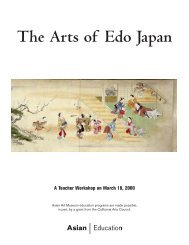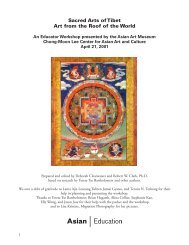Teacher Packet: Chinese Brushpainting (.pdf) - Asian Art Museum ...
Teacher Packet: Chinese Brushpainting (.pdf) - Asian Art Museum ...
Teacher Packet: Chinese Brushpainting (.pdf) - Asian Art Museum ...
You also want an ePaper? Increase the reach of your titles
YUMPU automatically turns print PDFs into web optimized ePapers that Google loves.
Introduction<br />
Brushstrokes: Styles and Techniques of <strong>Chinese</strong> Painting<br />
Brushwork is the essential characteristic of <strong>Chinese</strong> painting. Ink and brushwork provide the foundation<br />
of <strong>Chinese</strong> pictures, even when color is also used. Connoisseurs of <strong>Chinese</strong> art first notice the<br />
character of the line when they view a painting. In the quality of the brushwork the artist captures<br />
qiyun, the spirit resonance, the raison d'etre of a painting.<br />
<strong>Chinese</strong> Calligraphy and Writing<br />
In China, painting and writing developed hand in hand, sharing the same tools and techniques. Some<br />
sort of pliant brush, capable of creating rhythmically swelling and diminishing lines, appears to have<br />
been invented by the Neolithic period (ca. 4500-2200 B.C.E.) where it was used to decorate pottery<br />
jars with sweeping linear patterns. By the Han dynasty (206 B.C.E.-C.E. 220), both wall paintings<br />
and writing on strips of bamboo laced together to form books exhibit proficiency and expressiveness<br />
with the extraordinarily resilient <strong>Chinese</strong> brush and ink.<br />
<strong>Chinese</strong> writing is composed of block-like symbols which stand for ideas. Sometimes called “ideograms,”<br />
the symbols more often are referred to as “characters.” These characters, which evolved from<br />
pictograms (simplified images of the objects they represent), were modified over time to represent<br />
more abstract concepts. Calligraphers soon codified and regularized these symbols, designing each one<br />
to fit into an imaginary square, whether it is composed of one or sixty-four strokes. Furthermore,<br />
writers draw each of the strokes of a character in a particular order, essentially from left to right and<br />
from top to bottom. This information is essential for readers trying to decipher cursive script styles<br />
where some or all of the strokes are joined together (see Chart E).<br />
Calligraphy, the art of "beautiful writing," developed rapidly, soon yielding several forms of script.<br />
The clerical and regular scripts are made up of short, separate strokes that could be written easily<br />
with brush and ink. As the joy of writing took hold, calligraphers invented more styles, including the<br />
running and cursive scripts where they joined some or all of the character’s dots and lines that they<br />
wrote separately in the more formal styles (see slides 1 and 2).<br />
In writing, the <strong>Chinese</strong> seek to balance the size and relationship of one stroke with another and one<br />
character with another. Creating harmony between density and sparseness, top and bottom, left and<br />
right become second nature to the practiced calligrapher. This training in formal relationships and<br />
the use of the fluid ink and resilient brush led naturally to the translation of the art of writing to<br />
the art of painting.<br />
1 <strong>Asian</strong> <strong>Art</strong> <strong>Museum</strong>
















